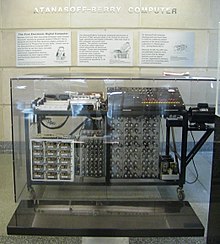Atanasoff-Berry computer
The Atanasoff-Berry Computer ("ABC") was one of the first electronic digital computers and was built by John Atanasoff and Clifford Berry at Iowa State College in 1937–1941 . The machine was based on the binary number system. Their sole purpose was to solve large systems of linear equations . The ABC was not a computer in the modern sense because it was not freely programmable.
The tube computer designed in 1937 was able to process 29 linear equations simultaneously and was successfully tested. When its inventors left the university in 1942 due to military operations, the mechanism was still unreliable and prone to failure. Many important elements of modern computer technology were used in the ABC for the first time, such as building blocks for binary arithmetic.
John Atanasoff's work did not become known to the general public until the 1960s. At the time, there was a patent dispute over who had developed the first automatic electronic digital calculator in the United States of America. The ENIAC is usually traded as such , although a US district court in 1973 ruled in a controversial but unchallenged judgment that the ENIAC patents were ineffective because the ABC was to be regarded as the first computer.
Atanasoff was awarded the National Medal of Technology at a ceremony in the White House by US President George HW Bush on November 13, 1990 .
technology
Even if not all the criteria that characterize modern computers have been met, three important aspects have been realized:
- No mechanical parts (switches, wheels, etc.) to carry out the calculations
- Use of the binary number system
- Separation of calculation unit and memory
Drum memories with a total storage capacity of approx. 3000 bits were used for data storage . Approx. 30 arithmetic operations (additions / subtractions) could be carried out per second.
User inputs were made using a punch card , and there was a display on the front for output. Paper webs that the device could write to and read in again served as intermediate storage, an error-prone storage technology, because since no parity bits were known yet , it was not possible to recognize when a written value was incorrectly read in again. The error rate was one error per 100,000 operations.
replica
The original ABC was dumped when the University of Iowa converted the basement it was built in into classrooms. All that was left was a single storage drum. In 1997, a research team from the Ames Laboratory , which is located on the Iowa State University campus, succeeded in completing a working replica. With this replica any last doubts about its functionality were dispelled. The cost of this project was $ 350,000. The new ABC is now open to the public as part of a permanent exhibition at the Durham Center for Computation and Communication at Iowa State University.
Comparison with other early computers
| Computer model | country | Installation | Floating point arithmetic |
Binary | Electronically | Programmable | Mighty Turing |
|---|---|---|---|---|---|---|---|
| Zuse Z3 | Germany | May 1941 | Yes | Yes | No | Yes, using punched tape | Yes, without any practical use |
| Atanasoff-Berry computer | United States | Summer 1941 | No | Yes | Yes | No | No |
| Colossus | UK | 1943 | No | Yes | Yes | Partly, by rewiring | No |
| Mark I. | United States | 1944 | No | No | No | Yes, using punched tape | Yes |
| Zuse Z4 | Germany | March 1945 | Yes | Yes | No | Yes, using punched tape | Yes, without any practical use |
| around 1950 | Yes | Yes | No | Yes, using punched tape | Yes | ||
| ENIAC | United States | 1946 | No | No | Yes | Partly, by rewiring | Yes |
| 1948 | No | No | Yes | Yes, using the resistor matrix | Yes |

